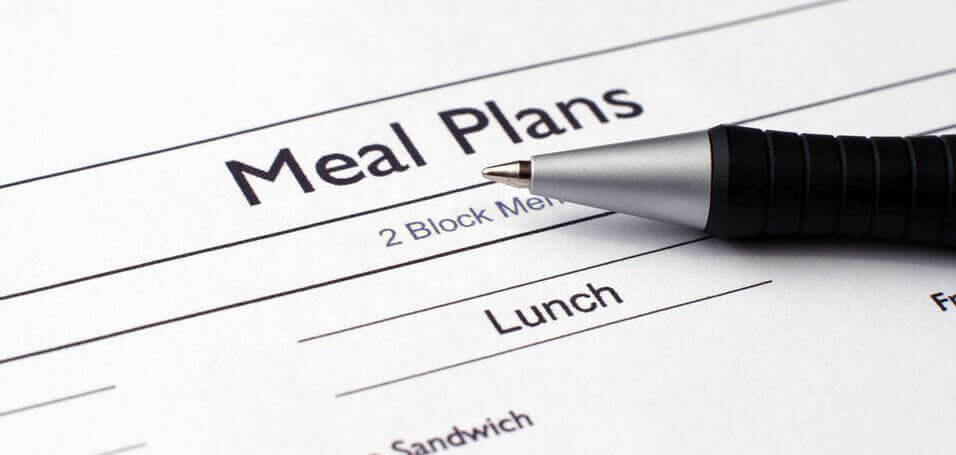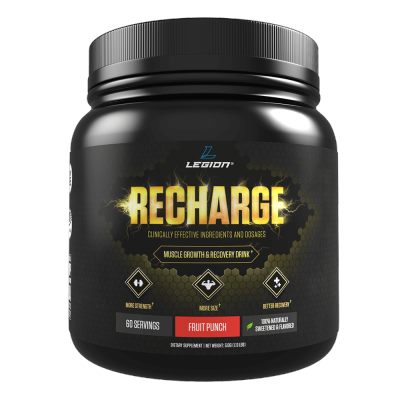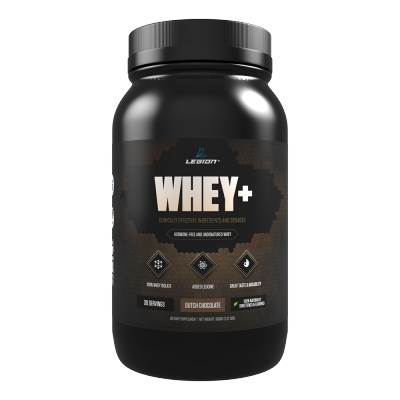Bulking is a controversial topic.
Some say it’s the only way to gain muscle effectively, and others say it’s a relic of the Dark Ages of bodybuilding.
“You gotta eat big to get big,” the former say.
“No,” the latter reply, “you just have to eat right.”
That is, traditional bulking maintains that, to achieve maximum muscle growth, you should do whatever it takes to cram down thousands of calories per day (GOMAD, for example), and accept rapid fat gain as a price to be paid.
Followers of the new philosophy, however, say that you don’t have to eat a large surplus of food and gain a large amount of body fat to build muscle effectively.
If you train right, and ensure you’re recovering adequately, they claim, you don’t need to cudgel your body with calories to grow.
Who’s right? Well, both are.
Old-school bulkers are correct in that you need to eat more food than usual to build muscle efficiently, and new-schoolers are correct in that ballooning your body fat percentage is not only unnecessary for muscle building, but detrimental.
There’s a sweet spot is in the middle, which is where clean bulking enters the picture.
It marries what bodybuilders have known anecdotally for decades with what modern scientific research into muscle hypertrophy has revealed, giving you the best of both worlds.
In other words, clean bulking allows you to gain muscle as quickly as possible, without forcing you to get fat in the process.
And in this article, we’re going to break it all down.
You’re going to learn where “dirty bulking” misses the mark, why clean bulking works better, and how to actually go about doing it.
Let’s get started.
- The 3 Biggest Mistakes You Can Make While Bulking
- What Is Clean Bulking?
- How to Clean Bulk In 6 Simple Steps
- What About Supplements?
- The Bottom Line on Clean Bulking
Table of Contents
+Want to listen to more stuff like this? Check out my podcast!
The 3 Biggest Mistakes You Can Make While Bulking
If you’ve heard that bulking is an inefficient, or even ineffective, way to gain muscle, you’ve been shortchanged, because it’s all about execution.
Do it right, and you’ll achieve maximum muscle growth with minimal fat gain. Do it wrong, though, and you’ll gain too much fat too quickly to care about anything else.
So, let’s start with looking at the latter: what constitutes “wrong.”
The first mistake is simply eating too many calories.
While eating slightly more calories than you burn every day is conducive to muscle growth (more on this soon), eating a lot more isn’t more so.
That is, you’ll gain just as much muscle eating ~110% of your total daily energy expenditure as you would eating 120 or 130%.
The only thing that will change, really, is how much fat you’ll gain.
If you stick to 110%, you’ll slowly gain small amounts of fat over the course of several months.
If you keep intake at 120% or 130% of TDEE, or more, however, you’ll gain significantly more fat significantly faster.
This causes bigger problems than just ruining your “aesthetics,” too: it further accelerates fat storage and slows down muscle growth.
You see, as body fat levels rise, two things happen:
Insulin is a hormone that shuttles nutrients into cells, and the better your body responds to its signals, the better it can do many things, including build muscle and resisting fat gain.
As the body becomes resistant to insulin, however, its ability to burn fat drops, the likelihood of weight gain rises, and protein synthesis is suppressed. In other words, as insulin sensitivity falls, the harder it gets to gain muscle, and the easier it gets to gain fat.
2. Testosterone levels drop and estrogen levels rise.
Testosterone is the primary hormonal driver of muscle growth and high levels of estrogen promote fat storage, so the downsides here are clear.
As you can see, excessive fat storage while bulking is a triple-whammy:
- It slows muscle growth.
- It increases fat gain.
- It makes losing fat after bulking even harder.
(And if you’d like even more specific advice about how many calories, how much of each macronutrient, and which foods you should eat to reach your weight-loss goals, take the Legion Diet Quiz.)
The second mistake is eating too much junk food.
Many people either don’t know, or don’t want to know, that food is more than just a source of calories, protein, carbs, and fat.
It’s also our source of vital micronutrients (i.e. vitamins and minerals) that our bodies need to remain healthy and function optimally.
A major problem with candy and other sugary treats, overly processed foods, fast food, and even some “health bars,” is they’re high in calories but low in micronutrients.
If you eat too much of these types of foods, you can develop nutritional deficiencies that increase the risk of all kinds of different health problems, such as diabetes, heart disease, infertility, and cancer.
The bottom line is while you can “get away” with eating a lot junk food if all you care about is how you look in the mirror, you’re eventually going to have to deal with the consequences.
Who cares how jacked you look if your hormones are whacked, your immune system is suppressed, and your body is starving for nutrients.
The third mistake is “cheating” too often.

When we’re talking diet, there are two ways to “cheat”:
1. Eating more calories than you generally would, regardless of what foods you eat.
2. Eating a lot of junk, even if it “fits your macros.”
We’ve already touched on why number two is a problem, so let’s take a closer look at number one.
This usually takes the form of a “cheat meal” or even a “cheat day,” where you eat whatever you want.
While I’m all for regularly increasing caloric intake while cutting (refeeding is great, for example), it has no physiological benefit while bulking. It’ll just make you gain fat faster.
It can get really out of hand, too.
For example, let’s say you stick to your meal plan during the week, but over the weekend, hit the Cheesecake Factory, and order, among other things, a brûléed French toast.
Little did you know, that dish alone packs a whopping 2,780 extra calories, which are added on top of whatever else you ate that day. And then there’s the appetizer(s) and dessert!
The problem is the same with other favorite cheat meals, like egregious amounts of pizza, ice cream, cookies, and the like. The extra calories add up, and fast.
Now, that doesn’t mean that you can’t stray from your meal plan while bulking and eat stuff that you normally wouldn’t.
You can, but you just need to go about it intelligently (which we’ll talk about later in this article).
What Is Clean Bulking?
Clean bulking is a method of dieting that maximizes muscle growth and minimizes fat gain.
It requires that you do just two things:
1. Regulate your caloric intake.
2. Get most of your calories from nutritious foods.
Let’s take a look at each.
Why you need to regulate your caloric intake while bulking.

I mentioned earlier that eating more calories than you burn every day helps you build muscle faster.
The reason for this is it’s the most reliable way to make sure that you’re not eating fewer calories than you burn, which is undesirable when you’re trying to gain size for several reasons:
1. It impairs your body’s ability to synthesize muscle proteins.
That is, your body just can’t add to muscle tissue efficiently when in a caloric deficit.
2. It reduces anabolic and increases catabolic hormone levels.
This further blunts your body’s ability to build muscle.
3. It reduces workout performance.
The more you have to struggle through your workouts, the less likely you are to progress in your training and gain muscle as a result.
The bottom line is the less time you spend in a caloric deficit, the faster you can gain muscle and strength.
And clean bulking is the easiest way to accomplish this, because it allows you to ensure that you’re always eating just a bit more energy than you’re burning.
That’s why I recommend that you eat just 10 to 15% more calories than you’re burning every day.
That’s enough of a buffer to prevent you from accidentally eating too little, but not so much than you’ll gain unnecessarily large amounts of fat.
(And again, if you feel confused about how many calories, how much of each macronutrient, and which foods you should eat to reach your goals, take the Legion Diet Quiz to learn exactly what diet is right for you.)
Why you should get most of your calories from nutritious foods.
Remember that food is more than a source of just calories and macronutrients.
It’s also our only way to get the many essential nutrients that our bodies need stay healthy, ward off disease, and recover from intense training.
A good rule of thumb is to get at least 80% of your calories from whole, minimally processed foods.
For example, I get the majority of my calories from foods like these:
- Avocados
- Greens (chard, collard greens, kale, mustard greens, spinach)
- Bell peppers
- Brussels sprouts
- Mushrooms
- Baked potatoes
- Sweet potatoes
- Banana & berries
- Low-fat yogurt
- Eggs
- Seeds (flax, pumpkin, sesame, and sunflower)
- Beans (green, black, garbanzo, kidney, navy, pinto)
- Almonds, pecans, cashews, peanuts
- Barley, oats, quinoa, brown rice
- Halibut, cod, tilapia, sea bass, tuna
- Lean beef, lamb, venison
- Chicken, turkey
If you do that, then you can use the remaining 20% (or less) calories on whatever you’d like.
For me, it’s usually a treat like chocolate or a low-calorie dessert of some kind, but it can be more or less anything, so long as the numbers add up.
How to Clean Bulk In 6 Simple Steps

You now know what clean bulking is, and why it’s superior to the sloppier “dirty” approach.
All you need, now, is to know how to put the rubber on the road.
Let’s get to it.
1. Calculate your calories.
As you know, clean bulking revolves around keeping your caloric intake slightly above what you’re burning.
How do you turn that into an actual number, though?
Well, you need to first determine your approximate total daily energy expenditure (TDEE), here’s a simple calculator that will help:
Want to save your results?
Enter your email so we can send them to you.
If you want to learn more about how this calculator works, read this.
2. Calculate your macros.
Once you have your target caloric intake worked out, you need to calculate your “macros” next.
“Macro” is short for “macronutrient,” which is a nutrient that your body needs in large amounts to survive. And in this case, we’re referring to the three major players: protein, carbs, and fat.
So, here’s how you want to set up your macros for clean bulking:
Eat 0.8 to 1 gram of protein per pound of body weight.
This will give your body all the raw materials needed to build as much muscle as possible.
Set your fat intake at 0.3 grams per pound.
This will support hormone synthesis and overall health, while allowing for plenty of carbs.
Use your remaining calories on carbs.
Carbs are your friend when you’re looking to maximize muscle growth, and this is why I recommend a relatively high carb intake.
You see, when you restrict your carb intake, your muscle glycogen levels drop, and research shows that low glycogen stores inhibits genetic signaling related to post-workout muscle repair and growth.
In other words, a low-carb diet creates an environment in your body that’s less conducive to post-workout recovery.
Studies also show that when you’re exercising regularly, restricting your carbs raises your cortisol and lowers your testosterone levels, which further hampers your body’s ability to recover from your workouts.
This is why study after study has shown that athletes who eat low-carb diets recover slower from their workouts and gain less muscle and strength than athletes who eat more carbs.
It’s also worth mentioning that eating a low-carb diet will decrease your strength and muscle endurance, which makes it harder to progressively overload your muscles in the gym and thereby maximally stimulate muscle growth.
To save time, here’s an expanded calculator that you can use to calculate your macros as described above:
Want to save your results?
Enter your email so we can send them to you.
If you want to learn more about the “macronutrient” style of dieting, read this.
3. Make a meal plan.

If you want the best chances for success when clean bulking, then you want to create and follow a proper meal plan.
Intuitive eating can work well for maintaining body weight and composition, but its lack of precision makes it poorly suited to losing fat or gaining muscle.
Meal planning, on the other hand, takes all the guesswork out of your diet. You know exactly what to eat every meal, every day, and why.
Check out this article to learn more about creating meal plans that really work.
4. Cheat intelligently.
I mentioned earlier that cheating too frequently or egregiously while bulking quickly fouls the nest.
I also mentioned that there’s a better way of going about it, and here it is.
1. Cheat once per week and try not to exceed 150% of your normal caloric intake for the day.
This gives you wiggle room for treats without resulting in what would normally be several weeks’ worth of fat gain in one go.
2. Try to keep your dietary fat intake under 100 grams on the day that you cheat.
This helps you control your caloric intake (fat has 9 calories per gram), and helps minimize total fat storage for the day, as dietary fat is converted to body fat more easily than carbs.
3. “Save up” calories for a cheat meal.
Let’s say you’re going to hit your favorite restaurant for dinner, and you plan on eating a lot.
What you can do, then, is eat nothing but protein leading up to the dinner, so you come into it having eaten far less than normal for the day.
This gives you you plenty of room to eat in the meal without having to worry about grossly overshooting your numbers.
And, speaking of restaurants, you should know that it’s generally some of the highest calorie food that you can eat.
Their job is the produce delicious food, and that means copious amounts of oil, butter, and sugar, and thus, calories.
This helps explain research conducted by scientists at Tufts University that involved the analysis of 360 dinner entrees at 123 non-chain restaurants in San Francisco, Boston, and Little Rock between 2011 and 2014.
They found that the restaurant dishes contained 1,200 calories, on average, and that American, Italian, and Chinese restaurants were the worst offenders, with an average of nearly 1,500 calories per meal.
That agrees with another study conducted by researchers at the University of Illinois that concluded that, calorically speaking, there’s not much of a difference between fast food and full-service dining.
All this is why I recommend caution when eating out.
Pay attention to ingredients and portions, and choose accordingly (anything with a creamy sauce or large amount of cheese, for example, is dangerous territory ).
5. Adjust your food intake based on how your body responds.

If you follow this plan, a man can expect to gain about 0.25 to 1 pound per week, and a woman can expect to gain 0.25 to 0.5 pounds per week.
If you’re gaining more than this, you’re probably eating too much and need to dial it back.
Trim 100 to 150 calories from your carbs and/or fats, and see how your body responds over the next 7 to 10 days.
If you’re gaining less (next to nothing, basically), then you need to eat more.
Add 100 to 150 calories to your protein and/or carbs, and see how your body responds over the next 7 to 10 days.
6. Be patient.
The right expectations are just as important as everything else discussed so far.
If you’re clinging to an unrealistic goal for muscle growth you’re setting yourself up for disappointment and failure.
Know this: if you want to dramatically change your physique, it’s going to take more time than you probably think.
Forget the hyperbole used to sell you supplements, magazines, and workout programs. You can’t transform your body in a month or two and you can’t pack on 50+ pounds of muscle in a year.
Here’s what you can do, though, with consistent, dedicated and proper training and dieting:
- Men can gain 15 to 25 pounds of muscle in their first year of weightlifting. Women can gain about half of that.
- Men can gain 8 to 13 pounds of muscle in year two. Women can gain about half.
- Men can gain 5 to 6 pounds of muscle in year three and 2 to 3 pounds per year each successive year. Women’s numbers are again halved.
If you’d like to learn more about the science and reasoning behind those guidelines, check out this article.
If you’re new to weightlifting and want to go from a normal physique to a muscular, fit one, you can assume you’ll need to gain anywhere from 30 to 50 pounds of muscle as a man and about half that as a woman.
As you can see from the numbers above, that takes time. Anywhere from 1 to 3 to 4 years to be specific.
So don’t take up weightlifting as a quick fix. It’s not. It’s a lifestyle.
What About Supplements?

I saved this for last because, quite frankly, it’s far less important than proper diet and training.
You see, supplements don’t build great physiques–dedication to proper training and nutrition does.
Unfortunately, the workout supplement industry is plagued by pseudoscience, ridiculous hype, misleading advertising and endorsements, products full of junk ingredients, underdosing key ingredients, and many other shenanigans.
Most supplement companies produce cheap, junk products and try to dazzle you with ridiculous marketing claims, high-profile (and very expensive) endorsements, pseudo-scientific babble, fancy-sounding proprietary blends, and flashy packaging.
So, while workout supplements don’t play a vital role in building muscle and losing fat, and many are a complete waste of money…the right ones can help.
The truth of the matter is there are safe, natural substances that have been scientifically proven to deliver benefits such as increased strength, muscle endurance and growth, fat loss, and more.
As a part of my work, it’s been my job to know what these substances are, and find products with them that I can use myself and recommend to others.
Finding high-quality, effective, and fairly priced products has always been a struggle, though.
That’s why I took matters into my own hands and decided to create my own supplements. And not just another line of “me too” supplements–the exact formulations I myself have always wanted and wished others would create.
I won’t go into a whole spiel here, but if you want to learn more about my supplement line, check this out. (And if you’d like to know exactly what supplements to take to reach your fitness goals, take the Legion Supplement Finder Quiz.)
For the purpose of this article, let’s just quickly review the supplements that are going to help you get the most out of your clean bulking.
Creatine
Creatine is a substance found naturally in the body and in foods like red meat. It’s perhaps the most researched molecule in the world of sport supplements–the subject of hundreds of studies–and the consensus is very clear:
Supplementation with creatine helps…
You may have heard that creatine is bad for your kidneys, but these claims have been categorically and repeatedly disproven.
In healthy subjects, creatine has been shown to have no harmful side effects, in both short- and long-term usage. People with kidney disease are not advised to supplement with creatine, however.
So, if you have healthy kidneys, I highly recommend that you supplement with creatine. It’s safe, cheap, and effective.
In terms of specific products, I use my own, of course, which is called RECHARGE.
RECHARGE is 100% naturally sweetened and flavored and each serving contains:
- 5 grams of creatine monohydrate
- 2100 milligrams of L-carnitine L-tartrate
- 10.8 milligrams of corosolic acid
This gives you the proven strength, size, and recovery benefits of creatine monohydrate plus the muscle repair and insulin sensitivity benefits of L-carnitine L-tartrate and corosolic acid.
Protein Powder
You don’t need protein supplements to gain muscle, but, considering how much protein you need to eat every day to maximize muscle growth, getting all your protein from whole food can be impractical.
That’s the main reason I created (and use) a whey protein supplement. (There’s also evidence that whey protein is particularly good for your post-workout nutrition.)
WHEY+ is 100% naturally sweetened and flavored whey isolate that is made from milk sourced from small dairy farms in Ireland, which are known for their exceptionally high-quality dairy.
I can confidently say that this is the creamiest, tastiest, healthiest all-natural whey protein powder you can find.
Pre-Workout Drink
There’s no question that a pre-workout supplement can get you fired up to get to work in the gym. There are downsides and potential risks, however.
Many pre-workout drinks are stuffed full of ineffective ingredients and/or minuscule dosages of otherwise good ingredients, making them little more than a few cheap stimulants with some “pixie dust” sprinkled in to make for a pretty label and convincing ad copy.
Many others don’t even have stimulants going for them and are just complete duds.
Others still are downright dangerous, like USPLabs’ popular pre-workout “Jack3d,”which contained a powerful (and now banned) stimulant known as DMAA.
Even worse was the popular pre-workout supplement “Craze,” which contained a chemical similar to methamphetamine.
The reality is it’s very hard to find a pre-workout supplement that’s light on stimulants but heavy on natural, safe, performance-enhancing ingredients like beta-alanine, betaine, and citrulline.
And that’s why I made my own pre-workout supplement.
It’s called PULSE and it contains 6 of the most effective performance-enhancing ingredients available:
- Caffeine. Caffeine is good for more than the energy boost. It also increases muscle endurance and strength.
- Beta-Alanine. Beta-alanine is a naturally occurring amino acid that reduces exercise-induced fatigue, improves anaerobic exercise capacity, and can accelerate muscle growth.
- Citrulline Malate. Citrulline is an amino acid that improves muscle endurance, relieves muscle soreness, and improves aerobic performance.
- Betaine. Betaine is a compound found in plants like beets that improves muscle endurance, increases strength, and increases human growth hormone and insulin-like growth factor 1 production in response to acute exercise.
- Ornithine. Ornithine is an amino acid found in high amounts in dairy and meat that reduces fatigue in prolonged exercise and promotes lipid oxidation (the burning of fat for energy as opposed to carbohydrate or glycogen).
- Theanine. Theanine is an amino acid found primarily in tea that reduces the effects of mental and physical stress, increases the production of nitric oxide, which improves blood flow, and improves alertness, focus, attention, memory, mental task performance, and mood.
And what you won’t find in PULSE is equally special:
- No artificial sweeteners or flavors.
- No artificial food dyes.
- No unnecessary fillers, carbohydrate powders, or junk ingredients.
And again, if you feel confused about what supplements you should take to reach your goals, take the Legion Supplement Finder Quiz to learn exactly what supplements are right for you. It’s the best way to ensure you get the most out of your supplement regimen.
The Bottom Line on Clean Bulking
Bulking is derided by many in the “evidence-based bodybuilding” crowd, and for good reason.
The old paradigm of force feeding yourself to force your muscles to grow bigger works, but we now know that there are smarter, better ways of going about it.
Clean bulking is just that.
It allows you to stay leaner while bulking, and, over time, gain muscle faster thanks to several physiological advantages.
So, get your hands on a well-designed weightlifting program, and then…
- Calculate your calories & macros.
- Calculate your macros.
- Make a meal plan.
- Cheat intelligently.
- Adjust your food intake based on how your body responds.
- Be patient.
And you’ll never struggle to gain lean mass again.
What are your thoughts on clean bulking? Have anything else to share? Lemme know in the comments below!
Scientific References +
- An R. Fast-food and full-service restaurant consumption and daily energy and nutrient intakes in US adults. Eur J Clin Nutr. 2016;70(1):97-103. doi:10.1038/ejcn.2015.104
- Urban LE, Weber JL, Heyman MB, et al. Energy Contents of Frequently Ordered Restaurant Meals and Comparison with Human Energy Requirements and US Department of Agriculture Database Information: A Multisite Randomized Study. J Acad Nutr Diet. 2016;116(4):590-598.e6. doi:10.1016/j.jand.2015.11.009
- Horton TJ, Drougas H, Brachey A, Reed GW, Peters JC, Hill JO. Fat and carbohydrate overfeeding in humans: Different effects on energy storage. Am J Clin Nutr. 1995;62(1):19-29. doi:10.1093/ajcn/62.1.19
- Burke LM, Hawley JA, Wong SHS, Jeukendrup AE. Carbohydrates for training and competition. J Sports Sci. 2011;29(SUPPL. 1). doi:10.1080/02640414.2011.585473
- Howarth KR, Phillips SM, MacDonald MJ, Richards D, Moreau NA, Gibala MJ. Effect of glycogen availability on human skeletal muscle protein turnover during exercise and recovery. J Appl Physiol. 2010;109(2):431-438. doi:10.1152/japplphysiol.00108.2009
- Lane AR, Duke JW, Hackney AC. Influence of dietary carbohydrate intake on the free testosterone: Cortisol ratio responses to short-term intensive exercise training. Eur J Appl Physiol. 2010;108(6):1125-1131. doi:10.1007/s00421-009-1220-5
- Creer A, Gallagher P, Slivka D, Jemiolo B, Fink W, Trappe S. Influence of muscle glycogen availability on ERK1/2 and Akt signaling after resistance exercise in human skeletal muscle. J Appl Physiol. 2005;99(3):950-956. doi:10.1152/japplphysiol.00110.2005
- Burke LM, Hawley JA, Wong SHS, Jeukendrup AE. Carbohydrates for training and competition. J Sports Sci. 2011;29(SUPPL. 1). doi:10.1080/02640414.2011.585473
- Tomiyama AJ, Mann T, Vinas D, Hunger JM, Dejager J, Taylor SE. Low calorie dieting increases cortisol. Psychosom Med. 2010;72(4):357-364. doi:10.1097/PSY.0b013e3181d9523c
- Cangemi R, Friedmann AJ, Holloszy JO, Fontana L. Long-term effects of calorie restriction on serum sex-hormone concentrations in men. Aging Cell. 2010;9(2):236-242. doi:10.1111/j.1474-9726.2010.00553.x
- Zito CI, Qin H, Blenis J, Bennett AM. SHP-2 regulates cell growth by controlling the mTOR/S6 kinase 1 pathway. J Biol Chem. 2007;282(10):6946-6953. doi:10.1074/jbc.M608338200
- Dzieniszewski J, Jarosz M, Szczygieł B, et al. Nutritional status of patients hospitalised in Poland. Eur J Clin Nutr. 2005;59(4):552-560. doi:10.1038/sj.ejcn.1602117
- Santosa S, Jensen MD. Adipocyte fatty acid storage factors enhance subcutaneous fat storage in postmenopausal women. Diabetes. 2013;62(3):775-782. doi:10.2337/db12-0912
- Griggs RC, Kingston W, Jozefowicz RF, Herr BE, Forbes G, Halliday D. Effect of testosterone on muscle mass and muscle protein synthesis. J Appl Physiol. 1989;66(1):498-503. doi:10.1152/jappl.1989.66.1.498
- Rohrmann S, Shiels MS, Lopez DS, et al. Body fatness and sex steroid hormone concentrations in US men: Results from NHANES III. Cancer Causes Control. 2011;22(8):1141-1151. doi:10.1007/s10552-011-9790-z
- Wang X, Hu Z, Hu J, Du J, Mitch WE. Insulin resistance accelerates muscle protein degradation: Activation of the ubiquitin-proteasome pathway by defects in muscle cell signaling. Endocrinology. 2006;147(9):4160-4168. doi:10.1210/en.2006-0251
- Shanik MH, Xu Y, Skrha J, Dankner R, Zick Y, Roth J. Insulin resistance and hyperinsulinemia: is hyperinsulinemia the cart or the horse? Diabetes Care. 2008;31 Suppl 2. doi:10.2337/dc08-s264
- Zhang J, Hupfeld CJ, Taylor SS, Olefsky JM, Tsien RY. Insulin disrupts β-adrenergic signalling to protein kinase A in adipocytes. Nature. 2005;437(7058):569-573. doi:10.1038/nature04140
- Dyck DJ, Heigenhauser GJF, Bruce CR. The role of adipokines as regulators of skeletal muscle fatty acid metabolism and insulin sensitivity. Acta Physiol. 2006;186(1):5-16. doi:10.1111/j.1748-1716.2005.01502.x














